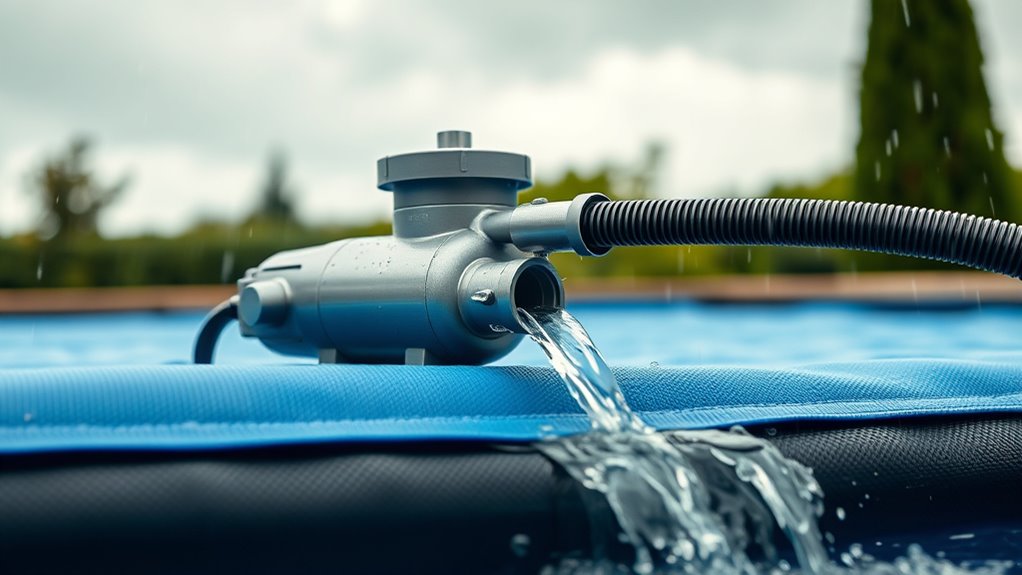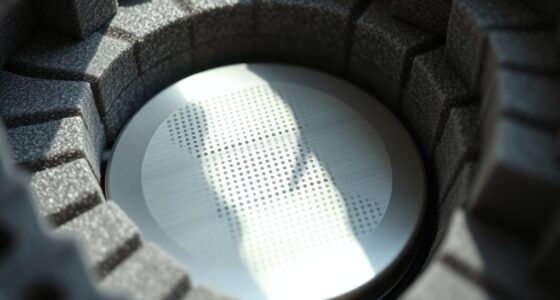Using a pool cover pump during rainy seasons helps you prevent water from overflowing, which can damage your cover and pool. It also reduces debris buildup, minimizes mosquito breeding, and extends the lifespan of your cover. Choosing the right pump and performing regular maintenance guarantee it works efficiently. Proper safety precautions are essential to avoid electrical hazards. Keep these tips in mind to manage your pool better—there’s more to know for smooth operation.
Key Takeaways
- Use a reliable, automatic or submersible pool cover pump to prevent water buildup during heavy rains.
- Regularly check and clean the pump and its components to ensure efficient operation.
- Place the pump on a stable, dry surface away from puddles and debris for optimal performance.
- Monitor water levels to prevent overloading the pump and causing malfunctions or leaks.
- Follow safety practices by using GFCI outlets and inspecting cords to avoid electrical hazards during wet conditions.
Benefits of Using a Pool Cover Pump During Rainy Periods

Using a pool cover pump during rainy periods helps prevent your pool from overflowing and minimizes water accumulation on the cover. This reduces the risk of excess weight damaging the cover or causing leaks. By removing excess water, you avoid unnecessary stress on the cover’s material, extending its lifespan. It also prevents the formation of stagnant water, which can become a breeding ground for mosquitoes and algae. Additionally, using a pump keeps your pool cleaner by reducing debris buildup caused by heavy rain. It saves you time on maintenance and keeps your pool water balanced. Incorporating efficient water removal strategies can optimize your pool maintenance routine and enhance overall safety during adverse weather conditions. Properly managing water levels with the help of a pump can also contribute to preventing equipment damage and ensure the longevity of your pool system. Furthermore, maintaining a proper water level can also contribute to the lifestyle by reducing stress and promoting a safe swimming environment. Incorporating weather-resilient equipment can further improve your pool’s durability during unpredictable weather.
Types of Pool Cover Pumps Suitable for Rainy Seasons
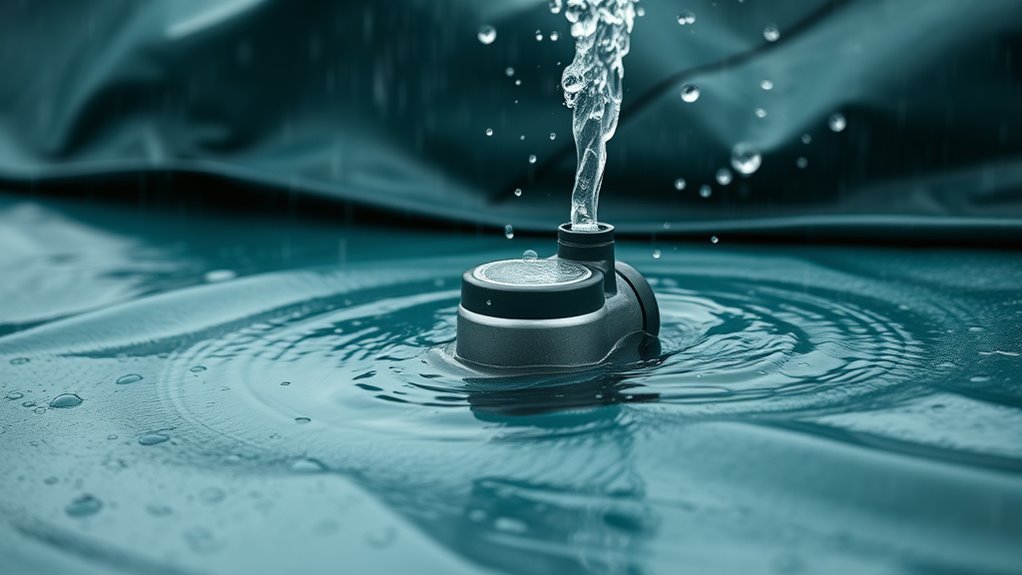
When choosing a pool cover pump for rainy seasons, you’ll want to compare submersible options that sit directly in the water. You should also consider whether manual pumps suit your needs or if automatic pumps will save you time and effort. Understanding the differences helps you select the best pump for reliable water management during heavy rains. Additionally, selecting a pump with features like a float switch can help prevent overflow and ensure efficient operation. As automation continues to advance, automation in business solutions like automatic pumps can improve your maintenance routine and reduce oversight. Proper maintenance and understanding of indoor air quality are crucial for ensuring your pump functions effectively during prolonged rainy periods. Incorporating security measures in your setup can also help safeguard your equipment from theft or damage during storms.
Submersible Pump Options
During rainy seasons, submersible pumps are an excellent choice for managing excess water on your pool cover because they can be fully submerged and operate effectively in wet conditions. They are designed to sit directly in the pooled water, making setup simple. When choosing a submersible pump, consider these options:
- Automatic submersible pumps that turn on when water reaches a set level, offering hands-free operation.
- Portable models with lightweight construction, easy to move around your pool cover.
- High-capacity pumps suitable for heavy rainfall, capable of draining large amounts of water quickly. Additionally, selecting a reliable pump with good reviews can ensure your system performs well season after season, especially since pump durability is critical for longevity in rainy conditions.
These options help you efficiently control water accumulation, preventing damage to your pool cover and maintaining your pool’s condition during heavy rains.
Manual vs. Automatic Pumps
Manual and automatic pool cover pumps each have distinct advantages for managing rainwater, and choosing between them depends on your specific needs. Manual pumps require you to operate them yourself, giving you control over when to drain excess water. They’re usually less expensive and simpler to maintain but require your attention during rainstorms. Automatic pumps, on the other hand, activate when water reaches a preset level, providing hands-free operation. This is ideal if you want to prevent water buildup without constant monitoring. Automatic pumps often have sensors and automatic shut-off features, reducing the risk of overdraining or damage. Your choice hinges on how much effort you’re willing to invest and how quickly you want the system to respond to changing water levels. Additionally, understanding hackathons can be useful for developing innovative solutions or automations for pool maintenance systems. Regular inspection of your pump components is essential to ensure drainage efficiency and prevent potential malfunctions. Incorporating smart technology can further enhance the effectiveness of your pump system, especially during unpredictable weather conditions, and being aware of pediatric sleep training techniques can help when managing sleep disruptions caused by weather-related noise or disturbances.
Key Features to Consider When Choosing a Pool Cover Pump
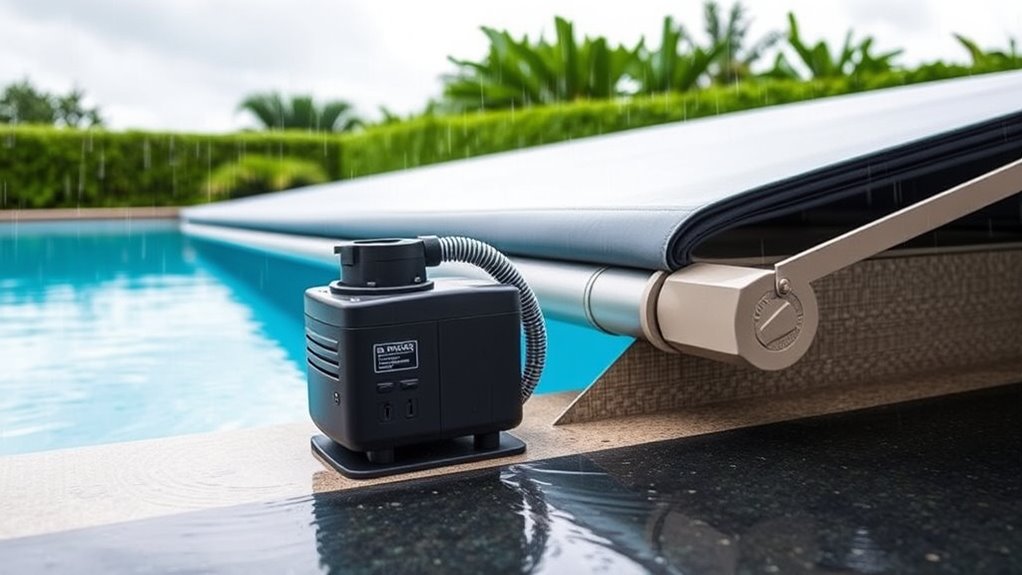
Choosing the right pool cover pump requires paying attention to several key features that guarantee efficient and reliable performance. First, consider the pump’s flow rate, which determines how quickly it can remove water—look for one with at least 800 gallons per hour for effective drainage. Second, check the pump’s power source; automatic pumps that plug into standard outlets offer convenience, while manual ones give more control. Third, evaluate durability and build quality, ensuring it’s made from weather-resistant materials to withstand rain and debris. Additionally, safety features like automatic shut-off prevent overheating and dry running. Incorporating automation features can further enhance efficiency by enabling remote operation and monitoring. Moreover, selecting a pump with weather-resistant materials ensures it remains functional even during heavy rain and adverse conditions. An understanding of performance capacity helps in choosing a pump that meets your specific drainage needs. Being aware of energy efficiency can help reduce long-term operational costs and environmental impact. By focusing on these features, you’ll select a pump that efficiently handles rainwater, keeps your pool protected, and operates safely throughout the season.
Step-by-Step Guide to Operating Your Pool Cover Pump
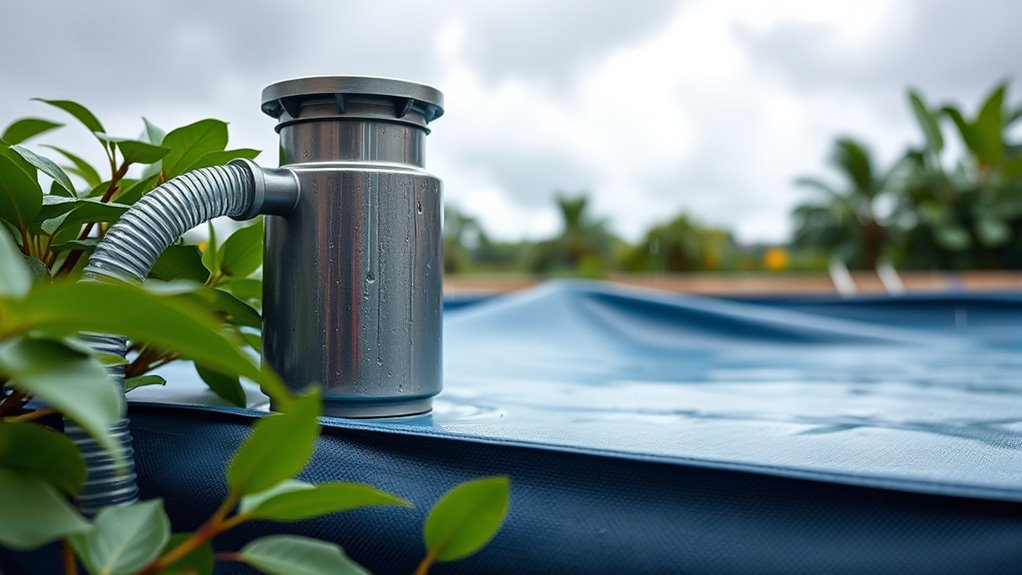
Operating your pool cover pump correctly guarantees efficient water removal and prevents damage. First, ensure the pump is placed on a flat surface and connected securely to a power source. Turn on the pump and monitor its operation closely. Check the water level regularly to prevent it from running dry, which can harm the motor. Use the following table to help you manage water levels effectively:
| Water Level | Action | Frequency |
|---|---|---|
| Above pump | Turn on the pump | When rain begins |
| Below pump | Turn off to avoid dry run | After rain stops |
| Excess water | Remove manually if needed | During heavy rain |
Stay attentive and adjust the pump as needed to maintain ideal operation. Regular maintenance and inspection ensure that the pump operates efficiently and has a longer lifespan, especially during rainy seasons. Being aware of water level fluctuations can help prevent pump failure and extend its durability. Additionally, proper placement of the pump can improve its efficiency during heavy rainfall. Properly maintaining the pump ensures consistent performance and reduces the risk of malfunctions during critical times. Checking for debris and routine cleaning can further enhance its longevity and performance.
Maintenance Tips for Ensuring Pump Efficiency
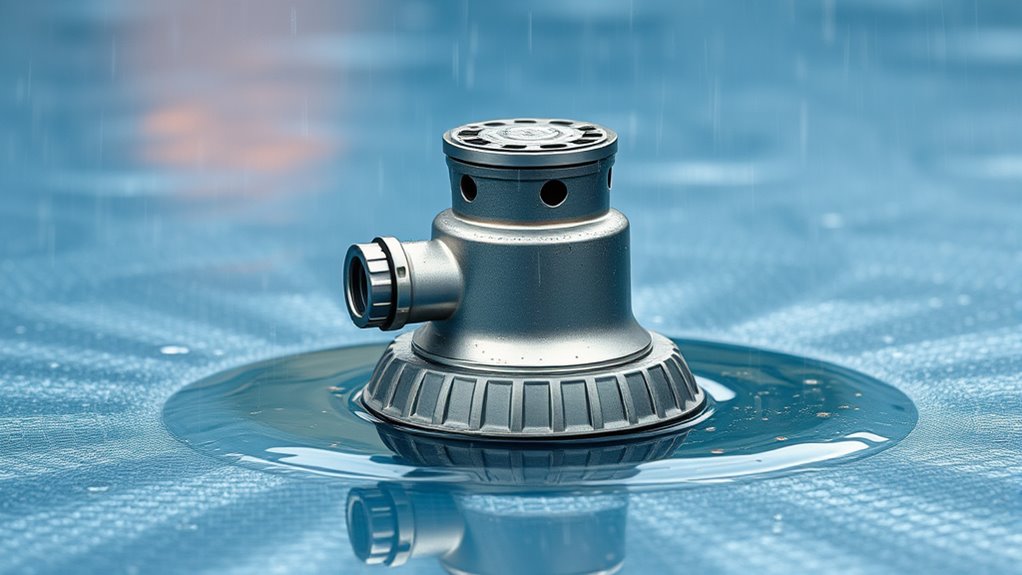
Regular maintenance is essential to keep your pool cover pump working efficiently throughout the rainy season. First, check the power cord and plug for any damage or wear, making certain a secure connection. Second, clean the pump’s intake strainer regularly to prevent debris buildup that can clog the system. Third, inspect the discharge hose for cracks or leaks and replace if necessary to maintain proper water flow. Additionally, keep the pump in a sheltered location when not in use to protect it from harsh weather. Regularly testing the pump’s operation helps catch issues early before they cause malfunctions. By sticking to these simple tips, you guarantee your pump remains reliable, prolongs its lifespan, and effectively manages rainwater accumulation on your pool cover.
Troubleshooting Common Issues With Pool Cover Pumps

If your pool cover pump isn’t turning on, it could be due to a power issue or a faulty connection. Excess water buildup might indicate a blocked intake or clogged filter, preventing proper drainage. Leaking or dripping from the pump often signals worn seals or loose fittings that need attention.
Pump Not Turning On
When your pool cover pump refuses to turn on during rainy seasons, it can be frustrating and worrying. First, check if the power source is working by testing the outlet with another device. Second, inspect the power cord and plug for damage or loose connections. Third, examine the float switch; if it’s stuck or obstructed, the pump may not activate. Sometimes, debris or dirt can block the switch, preventing operation. Ensuring the power supply is stable, the cord is intact, and the float switch moves freely can resolve most issues. If these steps don’t work, consider resetting the circuit breaker or replacing a faulty float switch. Addressing these common problems quickly keeps your pump functioning during heavy rains.
Excess Water Buildup
Excess water buildup on your pool cover can quickly overwhelm your pump, especially during prolonged rains. When too much water collects, it may cause your pump to shut off or fail to keep up. To visualize this, consider the following:
| Water Level | Pump Capacity | Result |
|---|---|---|
| High | Insufficient | Pump stalls or stops |
| Moderate | Adequate | Efficient water removal |
| Low | Minimal | No issues |
If water accumulates beyond your pump’s capacity, it can lead to flooding or damage. Regularly check the water level and ensure your pump is rated for the amount of water your cover collects. Clear debris and adjust the pump’s placement as needed to prevent overloads.
Leaking or Dripping
Leaking or dripping from your pool cover pump often indicates a problem that needs immediate attention. You might notice water around the pump base or see drops falling from fittings. To troubleshoot, consider these common causes:
- Loose fittings or clamps: These can loosen over time, allowing water to escape.
- Cracked or damaged seals: Seals may wear out, leading to leaks at connection points.
- Worn-out pump housing: Cracks in the pump body can cause continuous drips.
First, check all fittings and tighten any loose connections. Next, inspect seals and replace any that appear damaged. Lastly, examine the pump housing for cracks or wear. Addressing these issues promptly keeps your pump functioning efficiently and prevents further damage.
Safety Precautions for Using Pool Cover Pumps in Wet Conditions

Using a pool cover pump in wet conditions requires careful attention to safety to prevent electrical hazards and equipment damage. Always verify the pump is plugged into a GFCI outlet, which cuts power if a short occurs. Keep the power cord and plug dry; never touch them with wet hands. Place the pump on a stable, dry surface away from puddles or standing water. Inspect the cord and plug for damage before use, replacing any frayed or cracked parts. Avoid overloading circuits by not connecting multiple devices to the same outlet. Turn off and unplug the pump before performing maintenance or removing it from the water. Following these precautions helps you operate the pump safely, minimizing risks of shock or equipment failure during rainy seasons.
Frequently Asked Questions
Can a Pool Cover Pump Be Used for Other Water Removal Tasks?
A pool cover pump can definitely be used for other water removal tasks. If you need to clear water from a basement, a flooded yard, or a boat cover, this pump is handy. It’s designed to handle various water levels and can quickly drain pools, ponds, or even catch runoff after heavy rain. Just make sure the pump’s capacity matches the amount of water you need to move.
How Long Should I Run the Pump During Heavy Rain?
During heavy rain, you should run your pool cover pump until the water level drops below the cover’s edge, typically about 1 to 2 inches. Keep an eye on the water level to prevent overflow or damage. Don’t leave it running continuously for too long; check periodically to avoid overheating or overworking the pump. Proper timing guarantees efficient water removal and protects your pool area.
Are There Specific Electrical Safety Considerations in Wet Weather?
Did you know that electrical accidents increase by 30% during wet weather? When using a pool cover pump in rain, you must prioritize safety. Always guarantee your pump is properly grounded, use GFCI outlets, and keep all connections dry. Never operate electrical devices with wet hands or when standing in water. Taking these precautions helps prevent shocks and keeps you safe during heavy rain.
What Is the Typical Lifespan of a Pool Cover Pump?
The typical lifespan of a pool cover pump usually ranges from 3 to 5 years, depending on usage and maintenance. You should regularly clean and inspect your pump to guarantee it operates efficiently. Proper storage during off-seasons and avoiding debris can extend its life. If you notice decreased performance or unusual noises, it’s time to replace it to prevent water damage and ensure safety during heavy rains.
Can I Connect Multiple Pumps for Larger Pool Coverage?
You can connect multiple pumps for larger pool coverage, but you need to guarantee they work together properly. Use a Y-connector or a manifold to link them, allowing you to increase flow capacity effectively. Make sure the pumps are compatible and rated for the same voltage and pressure. Always monitor the setup to prevent overworking the pumps or causing leaks, and follow the manufacturer’s instructions for safe operation.
Conclusion
Using a pool cover pump during rainy seasons helps protect your pool from overflow and debris buildup. Choose the right pump, operate it properly, and keep up with maintenance to guarantee it works efficiently. Remember, “a stitch in time saves nine”—address issues early to prevent bigger problems later. With the right tools and care, you’ll keep your pool safe and pristine, rain or shine. Stay vigilant, and enjoy a worry-free swimming season!
